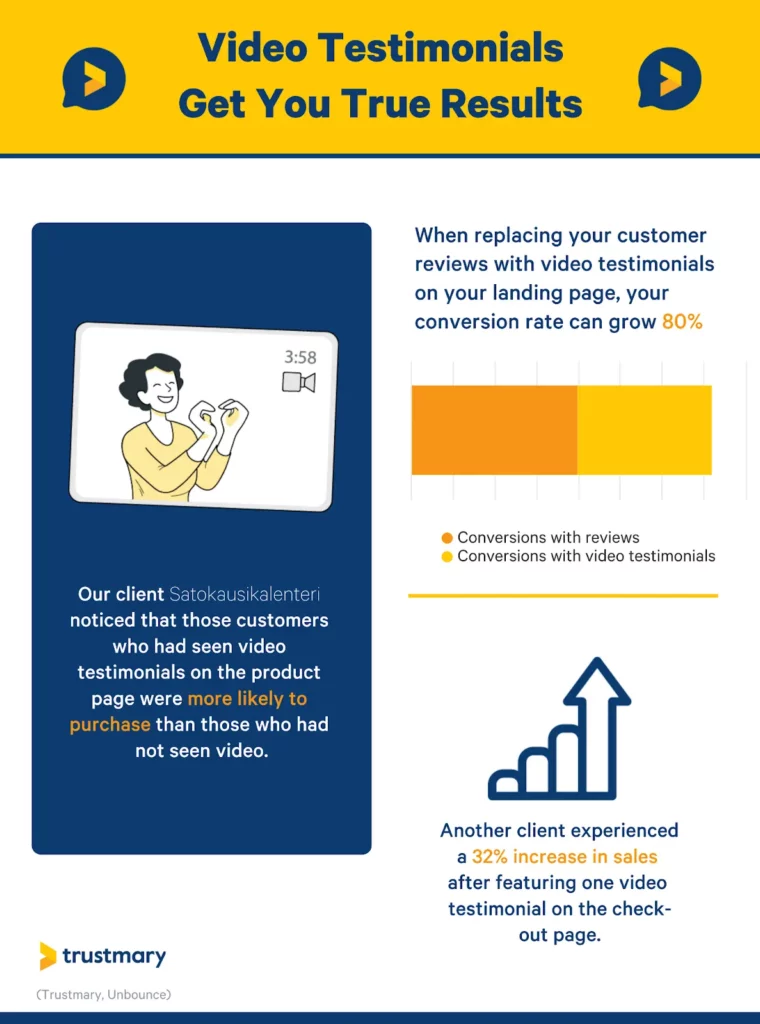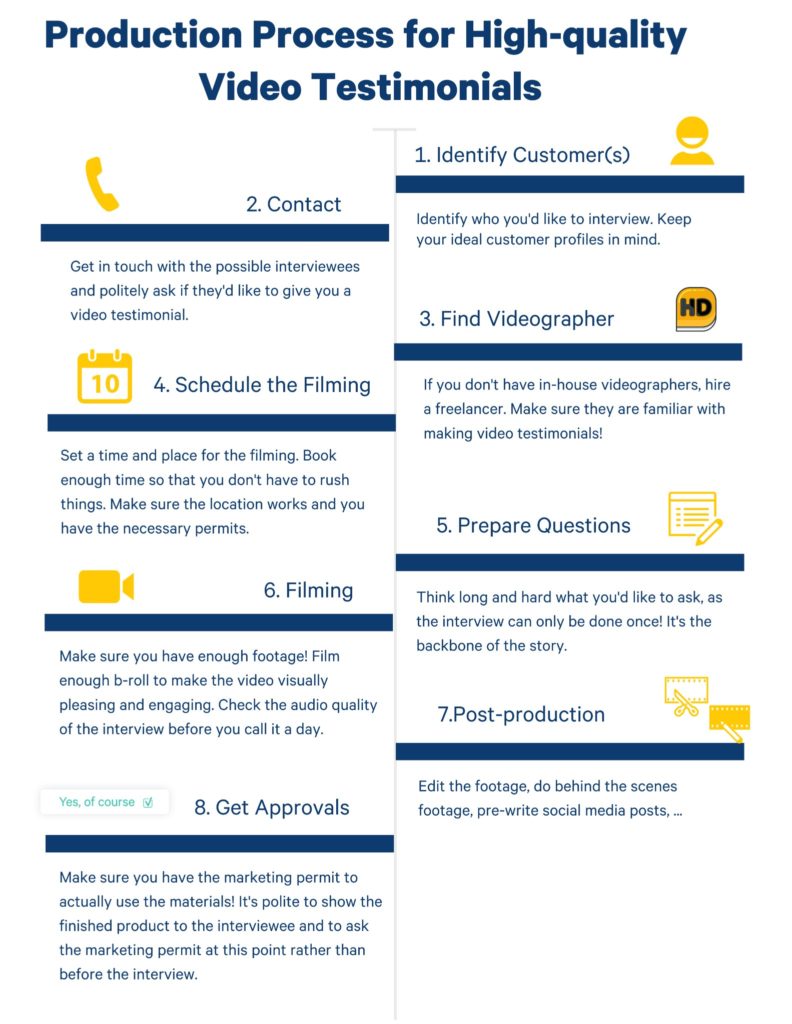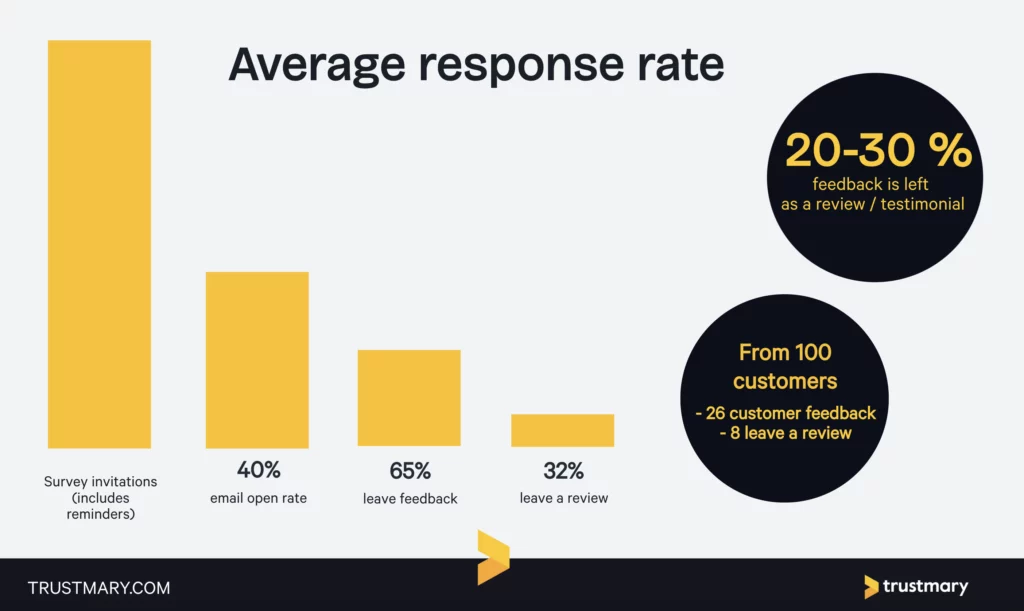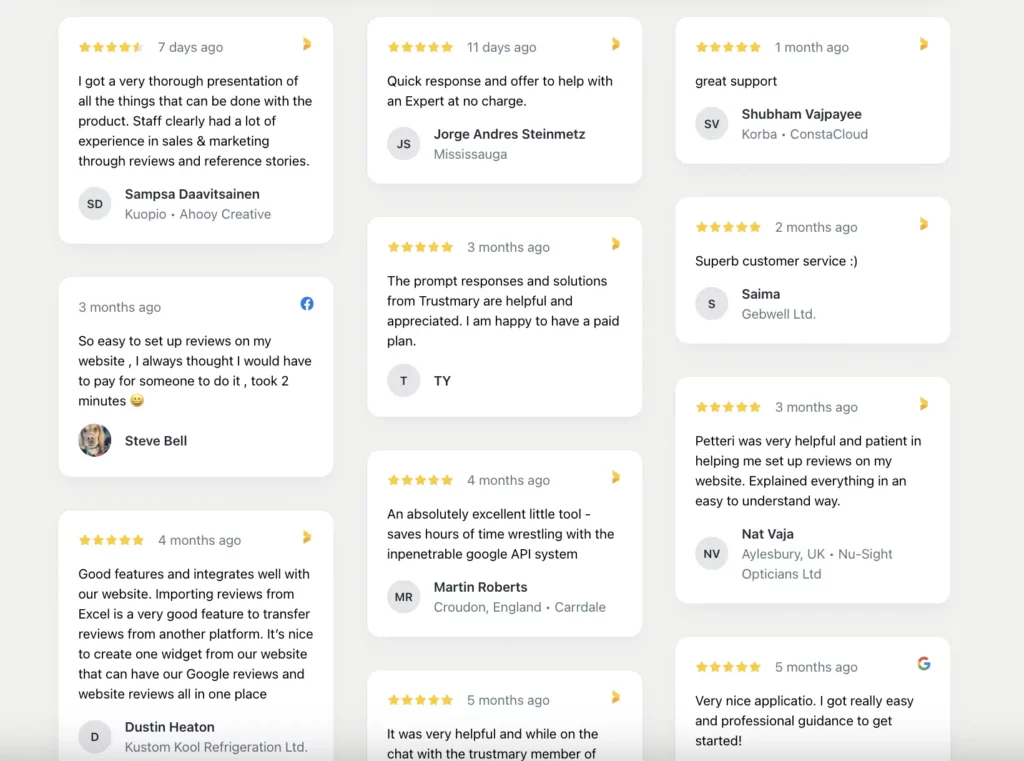Successful Remote Video Testimonial Campaign – in 14 days!

As you probably know, video testimonials add trust between you and your potential customers.
A video testimonial is a customer story that creates an emotional connection with the target audience. It’s part of a cost-effective content marketing strategy.
Testimonial video production is often seen as expensive and time-consuming. However, that is not the case when you implement remote video testimonials.
This guide will teach you how to execute a successful remote video testimonial campaign in 14 days.
I will also look at different ways to utilize the collected testimonials.
Remote Video Testimonials Work Like Magic 🪄
A great video testimonial can work wonders. Learn how to make video testimonials in two weeks!
Statistics show that video testimonials are more effective than regular written reviews. Based on our experience, prospective customers are 37% more likely to purchase if they see a video testimonial.

Customer video testimonials don’t have to be professionally produced to be effective.
You can easily collect testimonials from your customers by either doing it yourself or asking customers to record themselves.
If you want to make the process even easier, you can use a remote video testimonial tool like Trustmary.
Let’s see why you should take the pressure of picture-perfect video content off your shoulders and start utilizing the software.
1. You Get More Videos for Less Money and Effort
Take a moment to reflect on how much money and effort you spend on professional testimonial videos.
You must find the right clients, hire a video production team that might have to travel to the client, script the video, take it to post-production, make sure the client approves it, and pay lots of money for the process.
As a result, one video can cost thousands of dollars and several weeks. The quality will be top-notch, though.
When you use a remote video testimonial software tool, you might not get perfect quality, but you can get (in principle), unlimited video testimonials.
Only costs that you have come from possible subscription fees, and possible incentives for customers.

2. Selfie Video Testimonials Are Super Authentic
A professional customer testimonial video can come across as polished and scripted… which it is.
While this does not mean that the stories aren’t real, it can water down the social proof effect.
Selfie video testimonials are more relatable and authentic social proof. The customer films it on their own: no one has been affecting their answers.
It’s also a sign of great trust when your customers are willing to record a video for your marketing purposes.
How Do Video Testimonial Campaigns Work?
In case you are not familiar with how remote video testimonials work, here is a short recap:
- Implement a software tool, like Trustmary.
- Create a testimonial request form.
- Send it to your customers.
- Let your customers record the video directly on the form (or upload a video).
- The customer sends the video to you with one click.
- The video is stored in the Trustmary app, where you can view and manage all of your testimonials.
- You can easily display video testimonials on your website with widgets.
You can get started for free, and upgrade to advanced plans if you want to add on customer feedback surveys and testimonial automation options.

Now that you know this, let’s move on to how you can create a successful video testimonial campaign in just 14 days.
Day 1: Set Goals
Anything you do should start with setting goals.
Maybe you don’t know what realistic objectives look like, but that’s not the point.
Sometimes, the purpose of setting goals is to push you. Even if you have unrealistic goals, you will do your best to reach them. It will lead to better results than not planning ahead.
Your goals should include aspects for the input as well as the output.
Examples of input goals:
- Reaching out to every customer
- Reaching out to all happy customers (use NPS surveys to figure out who those are)
- Interview customers personally
And here are some output goals you might have:
- Getting X number of high-quality customer testimonial videos
- Raising your website conversion rate X amount with the video testimonials
- Increasing engagement on social media by X percent with testimonials
You might also want to have goals regarding what kind of testimonials you want.
Do you want the customers to discuss your products or services, or maybe your values?
Ultimately, whatever goals you set will determine how you will go about the campaign.
Days 2-3: Planning Stage
After you know the big picture, it’s time to start planning the campaign.
The planning stage can take at least 2-3 days, sometimes maybe longer.
Here are things you need to figure out during this stage.
1. How to Collect Video Testimonials?
What do you think is the most effective way to collect video testimonials from your customers?
It depends on many factors, such as:
- How large is your customer base?
- Do you personally meet your customers?
- Do your customers spend time online, on social media, or on your website?
- Are your customers technologically skilled or not?
- Do you have your customers’ personal contact information?
In case you run a local business, let’s say a restaurant, you probably don’t have your customer’s contact information. What is the best way to reach them? On the spot, or maybe through social media?
Perhaps you have a construction business, and you know your clients personally. You have a chance to call them, text them, send an email, or ask face to face.
Things like this determine if you can rely on remote video software and simply distribute links, or if your personal input is needed, too.
You can mix different methods: no one says you must stick with one strategy.
2. Where to Promote Your Campaign?
Promoting your campaign means informing the customers what you are looking for: what you expect from them, what is in it for them, and how you are going to use their testimonial videos.
You also need to convince your customers to take part in the campaign. Be persuasive and offer something in return (more about this in the next section).
You can do this e.g. by:
- Sending emails
- Posting on social media
- Calling them
- Asking personally
- Stating it on your website
- Advertise it
Much like in the previous step, you need to know the best channels based on your specific situation.
3. Prizes and Incentives
When talking about testimonial videos, people might need some extra motivation to record them.
After all, there can be a rather high threshold for giving your face, voice, and name to a company’s marketing purposes.
It’s important that your customers feel there is something in it for them, too.
Offering incentives and prizes to the participants can significantly increase your response rate.
The prize you’re going to offer depends on how many video testimonials you are aiming to collect and what kind of budget you have.
For a smaller budget, a lottery might be a good solution. Reserve 1-3 bigger prizes and let the fortune tell what happens next.
If you’re not lacking money, you can offer a prize for each participant. If it’s something physical, remember to take into account possible shipping costs.
4. Logistics and Responsibilities
It happens too often: no one is responsible for a project, which means no one is taking care of what happens.
And many things need to be considered during the project:
- Who promotes the campaign?
- Who responds to possible questions?
- Who monitors that everything goes as planned?
- Who filters through the testimonials and decides which ones are good to go?
- Who sends the possible prizes to participants?
- Who keeps track of received testimonials?
Assign at least one person to watch over the testimonial campaign.
When you use video testimonial software, there is little manual work, as the software takes care of e.g. collecting contact information, storing the responses, and tracking activity like response rate.
The responsible person doesn’t have to spend all their time on tasks related to the campaign. Checking in once a day should be enough.
5. Plan Your Questions
Testimonial videos are meant to be authentic customer stories. Thus the more freely your customers can tell about their experience, the better.
However, including questions or prompts helps your customers plan what to say in the video.
Additionally, the tips guide the customer to talk about specific themes you want to hear them speak about.
There are at least five themes that should be covered in each video:
- Customer’s background information
- Pain points/problems/wishes the customer had before
- How the co-operation/service/product has been
- What results have been achieved or how the product or service has changed the customer’s life
- Recommendations
See more tips on video testimonial questions to ask your clients.
Day 4: Set Up and Test
When the planning is done, you can set up the video testimonial tool.
Make the survey, including your questions, and choose the right distribution channel: link, email list, website, QR code, or SMS.
If you decide to send the video testimonial request via email, don’t forget to add an automatic follow-up email.
See tips on effective testimonial request letters and get inspired!
Once everything is set up, test it out. Make sure that everything works like it’s supposed to. Check that your customers can leave testimonial videos on desktop and mobile, and different browsers.
Ask someone else to complete the video testimonial survey to make sure the instructions are clear and it’s easy to use.
Day 5: Launch Campaign
Now you’re ready to launch the campaign!
Did you know that Friday afternoon is the best time for B2C and Friday morning for B2B businesses?
At those times, people are more likely to have time to participate in your campaign.
If your customers are active, you can start receiving video testimonials immediately after the launch.
For feedback surveys, the average numbers for Trustmary users look great:
- Average email open rate is 40%
- 65% of openers leave feedback
- 32% from those that gave feedback leave a review

With video, the numbers can be lower, as it take more effort from the customer to complete.
If you get a video testimonial request via email while you are sitting in your untidy house, wearing pajamas, and not having even brushed your teeth yet, the likelihood of you submitting a video review isn't zero, but close enough.
Timing is key, but also reminders.
Day 5-7: Advertise Across Channels
Start vigorous promotion of your campaign.
A single email is very easy to ignore and forget about. That’s why you need a follow-up email and other promotional efforts.
For example, you could make social media posts about the progress of your campaign. Here are a few examples.
On the launch day:
“We are collecting customer testimonial videos. Keep an eye on your email and submit your video through the link on the message. Participants get a surprise gift!”
A few days later:
“Have you claimed your gift yet? Check your email for a video testimonial request and submit your video to get it!”
Near the end of the campaign:
“You still have time to submit a video testimonial! If you haven’t received an email request, you can record the video through this link.”
Day 8-13: Re-promote, Ask Again, Showcase Acquired Content
After a few days, you have probably acquired some testimonial videos from your customers.
Now you can share great examples of content submitted.
This works as social proof: people see that others have submitted videos, they have a better idea of what is expected, and they feel more encouraged to film a video themselves.
You can display the testimonial videos on your social media channels, or add them to your follow-up emails.
14: Thank Participants and Inspect Results
It’s the last day of your campaign!
Thank your customers for sending in their video testimonials. Remember to complete the possible lottery and distribute the gifts.
You could also send a thank you email that features some of the best videos.
Now it’s also time to analyze your success.
- How many testimonials did you receive?
- How was their quality?
- Did you get what you expected?
- Did you accomplish your objectives?
- Should you do something differently next time?
Even if you did achieve the results you wanted, you now have a more realistic plan for your next campaign.
Start Using The Video Testimonials!
After the campaign, you can start utilizing the collected testimonial videos.
Some ideas include:
1. Create A Customer Testimonial Page
When you have collected many testimonials from happy customers, you can create a whole page dedicated to them.
It’s tiring to add testimonials to your website by hand, and difficult to make it look nice.
Luckily, you don’t have to do it manually: just use one of Trustmary’s widgets.
I recommend trying out the Wall of Love testimonial widget. It lets you showcase both video testimonials and written testimonials.

2. Display on Your Landing Pages or Product Pages
Video testimonials on your website landing pages and product pages boost conversions and help you get more sales.
When you place testimonials near CTAs, the website visitors are more likely to click on them.
Pages that convey crucial information about your product or service cannot be filled with customer testimonials.
You need a widget that doesn’t take up too much space but can display multiple testimonials.
Try the in-page embed widget:
When we are talking about high-stakes things like conversions and sales, you want to find the best video testimonials and widgets.
That’s why Trustmary helps you A/B test your widgets and choose the one that benefits your website the most.
3. Add to Blog Posts
If you write a blog for your business, try widgets dedicated to blog CTA’s, such as this one:
This method helps you get leads from the blog easier.
4. Post on Social Media
Pick the best testimonial video to post on social media.
You can even expand the idea and share customer testimonials regularly on your social media channels.
Switch it up from time to time and publish quote testimonials or other types of testimonials.
However, video content is usually the best-performing tactic. For example, on LinkedIn, video gets shared 20 times more than any other type of content!
Try posting testimonials on LinkedIn to engage your ICP!
5. Make A Compilation Video
By compiling several testimonial videos into one, you can get a commercial-worthy piece to share basically anywhere.
Take a short snippet of each video, add cool transitions and some background music, and make your brand visible with a logo and your slogan.
You can hire a professional to make your video ads, but if you have some skill and time on your hands, why not do it yourself with a video editing tool?
6. Use in Advertisements
Testimonial advertising is a great way to bring authenticity to your ad campaigns.
Video testimonials work amazingly as Meta, YouTube, LinkedIn and TikTok advertisements.
Conclusion on Video Testimonial Campaign
Executing a video testimonial campaign is possible in just 14 days when you use a software tool to help you.
Spend the first few days planning and setting up the process. After that, you can focus on promoting the campaign and reaping results.
Once you have collected testimonials, you can use them on your website and social media.
When you use Trustmary, you can choose between lots of testimonial widgets and test which one generates the most conversions.
Further Reading
- Video Testimonial Statistics That You Should Mind
- The Definitive Guide to Creating and Utilizing Video Testimonials
- Gather Video Testimonials that Improve Website Conversion Rate with Trustmary
- 5 Video Testimonial Questions to Ask from Clients
FAQ
What is the easiest and quickest way to make a video testimonial campaign?
If you want to collect video testimonials easily and quickly, use remote video testimonial software. Producing a customer testimonial video with a professional team can be pricy. But a software testimonial tool makes the process inexpensive (even free) and automatic.
How to launch a video testimonial campaign?
When you launch a video testimonial campaign, make sure you inform your customers clearly about the process. You must promote the campaign across different channels, and possibly offer an incentive for participants. Once that is sorted out, all you have to do is send a link to the video testimonial form via email.
Why should I execute a video testimonial campaign?
Video marketing is hot, and so is social proof. Video testimonials combine these two elements and turn your website into a lead generation machine. When you showcase authentic video testimonials from satisfied customers, you optimize the website conversion rate and get new customers.
